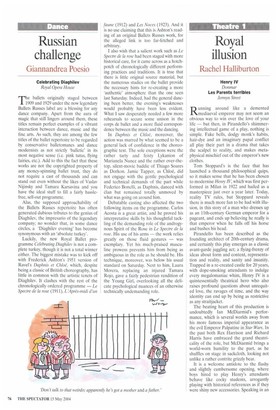Russian challenge
Giannandrea Poesio
Celebrating Diaghilev Royal Opera House
TI1e ballets originally staged between 909 and 1929 under the now legendary Ballets Russes label are a blessing for any dance company. Apart from the aura of magic that still lingers around them, these titles remain perfect examples of a vibrant interaction between dance, music and the fine arts. As such, they are among the few titles of the ballet repertoire to be regarded by conservative balletomanes and dance modernists as not strictly 'balletic' in its most negative sense (i.e. pink tutus, flying fairies, etc.). Add to this the fact that these works are not the copyrighted property of any money-spinning ballet trust, they do not require a cast of thousands and can stand out even without the likes of Vaslav Nijinsky and Tamara Karsavina and you have the ideal stuff to fill a fairly hasslefree, sell-out programme.
Alas, the supposed approachability of the Ballets Russes repertoire has often generated dubious tributes to the genius of Diaghilev, the impresario of the legendary company; no wonder that, in some dance circles, a 'Diaghilev evening' has become synonymous with an 'absolute turkey'.
Luckily, the new Royal Ballet programme Celebrating Diaghilev is not a complete turkey, though it is not a total winner either. The biggest mistake was to kick off with Frederick Ashton's 1951 version of Ravel's Daphnis et Chloe, which, despite being a classic of British choreography, has little in common with the artistic tenets of Diaghilev. It clashes with the rest of the chronologically ordered programme — Le Spectre de la rose (1911), L'Apres-midi d'un faune (1912) and Les Aroces (1923). And it is no use claiming that this is Ashton's reading of an original Ballets Russes work, for the alleged link is too far-fetched and arbitrary.
I also wish that a salient work such as Le Spectre de la rose had been staged with more historical care, for it came across as a hotchpotch of chronologically different performing practices and traditions. It is true that there is little original source material, but the numerous studies on the ballet provide the necessary hints for re-creating a more 'authentic' atmosphere than the one seen last Saturday. Indeed, had the general dancing been better, the evening's weaknesses would probably have been less evident. What I saw desperately needed a few more rehearsals to secure some unison in the corps de ballet and a more fluid correspondence between the music and the dancing.
In Daphnis et Chloe, moreover, the action was marred by what seemed to be a general lack of confidence in the choreographic text. The sole exceptions were the rather tarty and feisty Lykanion of Marianela Nunez and the rather over-thetop, silent-movie baddie of Thiago Soares as Dorkon. Jamie Tapper, as Chloe, did not engage with the gentle psychological and technical demands of the part while Federico BoneIli, as Daphnis, danced with élan but remained totally unmoved by what was going on around him.
Debatable casting also affected the two following items on the programme. Carlos Acosta is a great artist, and he proved his interpretative skills by his thoughtful tackling of the demanding role of the androgynous Spirit of the Rose in Le Spectre de la rose. His use of his arms — the work relies greatly on those fluid gestures — was exemplary. Yet his much-praised masculine prowess prevents him from being as ambiguous in the role as he should be. His technique, moreover, was below his usual standard on Saturday. Next to him, Laura Morera, replacing an injured Tamara Rojo, gave a fairly pedestrian rendition of the Young Girl, overlooking all the delicate psychological nuances of an otherwise technically undemanding role.


































































































 Previous page
Previous page